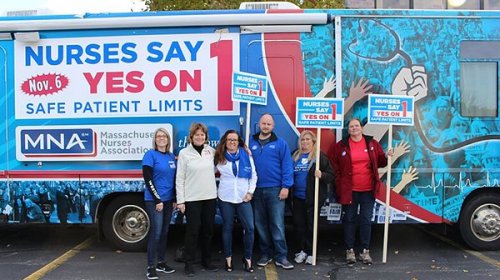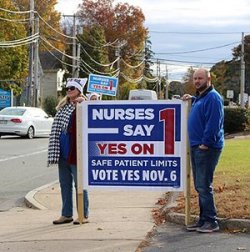Nurse staffing at the top of the ticket in Massachusetts
One ballot question has captured the attention of voters in the Bay State: whether or not to set safe patient limits for nursing care in hospitals. Question 1, backed by the Massachusetts Nurses Association, would require hospitals to limit the number of patients assigned to each nurse depending on the type of hospital unit and acuity of patients. The MNA, a union representing 23,000 nurses, tried for years to pass state legislation, and last year they began a campaign to let voters have a voice. While many AFT and nursing organizations have won safe staffing levels in their union contracts, only California has a state law limiting patient assignments for nurses.

Earlier this year, the AFT passed a resolution in support of the MNA’s campaign and recruited volunteers to help with the get-out-the vote efforts in the state. Seventeen AFT Nurses and Health Professionals are embedded in the state canvassing and phone banking until Election Day, including Rick Lucas, a member of the Ohio Nurses Association.
Lucas, a critical care nurse, used his vacation time to go to Massachusetts. A win there is that important to him. “Seeing this question being brought before the voters of Massachusetts is a big deal for us all,” says Lucas. “I’m hoping we can do something like this in Ohio to make our hospitals safer. We’ve seen a lot of nurses leave the bedside. It’s become a very demoralizing environment. We don’t really have time to get in there and make the difference that we want to make for patients.”
The voters he speaks to while phone banking or canvassing echo his point. “A lot of people have shared that they see how bare bones the staff is in hospitals,” he says. His most memorable call was with a woman who recently was left blind by a stroke. “She didn’t have a lot of friends or family, and the doctor told her the news,” and then he left. “But there was no one there to help her cope with the fact that she may never see again or to answer her questions or just be there for her.
“Seeing this question being brought before the voters of Massachusetts is a big deal for us all,” says Lucas. “I’m hoping we can do something like this in Ohio to make our hospitals safer.”
The opposition is misleading voters

The nurses have their work cut out for them. The Massachusetts Health and Hospital Association has spent millions to oppose the initiative. And the opposition is everywhere—from billboards and yard signs to television and newspaper ads. Most people seem to agree that giving nurses fewer patients generally leads to safer, healthier patients. But opposition efforts have succeeded in confusing the voters on the question by citing a range of concerns from the fear of long wait times in emergency rooms to the costs of hiring more nurses. That’s why our ground campaign is so important. The MNA along with its nurse volunteers from across the country are reaching people on the phones, at the polls for early voting, and in their homes; and the unionists are taking time to explain their position: Safe patient limits will ensure high-quality care and save lives.
“We get into nursing because we want to take care of people,” says Courtney Smith, a registered nurse and volunteer from the Oregon Federation of Nurses and Health Professionals.
When she talks to voters, she lets them know that the proposed change will mean nurses will have more time to give the proper care. “Think about it,” she says. “People are waiting in the ER—not because there are no beds, but because there’s no staff to take patients.”
Smith has seen the effects inadequate staffing can have on a hospital, recalling a stroke patient who waited in the emergency department for two days before going to go a skilled nursing facility because of short staffing. “Not having enough nurses to provide care and being told that there’s no one else you have to take on that load is tough, and that’s why I came out here.”
Smith is surprised by the opposition. “I never thought that this would be something people would say no to,” she says, noting that a lot of the opposition’s ads are misleading because the nurses featured are nurse executives or nurse managers. “Yes, they are nurses, but they are not bedside nurses,” says Smith. “They’re not the ones taking care of patients, giving meds, doing assessments, coordinating care with other health professionals.”

“Having nurses talk to people is so important because some people are confused, thanks to the opposition’s messaging on this, says Donna Kelly-Williams, president of the MNA. Unless you are one- on-one with people, they don’t get it.”
Laura Iacometta (pictured at left), a retired registered nurse from New Jersey agrees. If you talk to someone long enough, you start to talk about your experience, not about the statistics, she says. “I tell people why I couldn’t work on the floors any more: I couldn’t handle any more patients.”
Victory is so close
“We’ve gotten a lot of good responses but you are combating fear, like everything else going on in this country,” says Iacometta. “The rhetoric that’s being put out there tries to make nurses look bad, but we fight it by getting people to understand exactly what we do.”
Iacometta is part of a group of retired nurses from New Jersey’s Health Professionals and Allied Employees who traveled to Massachusetts to volunteer. They have worked for years trying to get safe staffing legislation passed in New Jersey; now, a victory in Massachusetts is so close, these nurses can taste it.
A win in Massachusetts “will make it easier for us,” says Pat Adago, who retired from long-term care nursing five years ago. Early voting is already underway in the state, which is why Adago is standing outside the polling station at Stoughton Town Hall holding a sign that reads: “Nurses say Yes on 1.” The afternoon sun is shining, the cold wind is biting; but every time drivers blow their horns in support, Adago waves and gives a big smile.
Barbara Egger likes to give voters the hard facts, especially those who say they are voting no. “When people are in a hospital, it’s because they need nursing care. Labor is the number one cost for hospitals, but you get what you pay for,” she says. Egger worked as a nurse for 34 years; and in that time, she says, “We’ve had to fight for anything that makes working conditions safer for nurses and patients—from safe needles to banning mandatory overtime. Every time we proposed change, the hospitals would scream, ‘We can’t do it because it costs too much’ or ‘it’s not realistic.’ But when we finally succeeded, the world didn’t fall apart, and staff and patients were safer because of it.”
A second wave of nurses from Alaska, Montana, New Jersey and Ohio are joining the team for the final get-out-the-vote effort through Election Day.
[Adrienne Coles]
